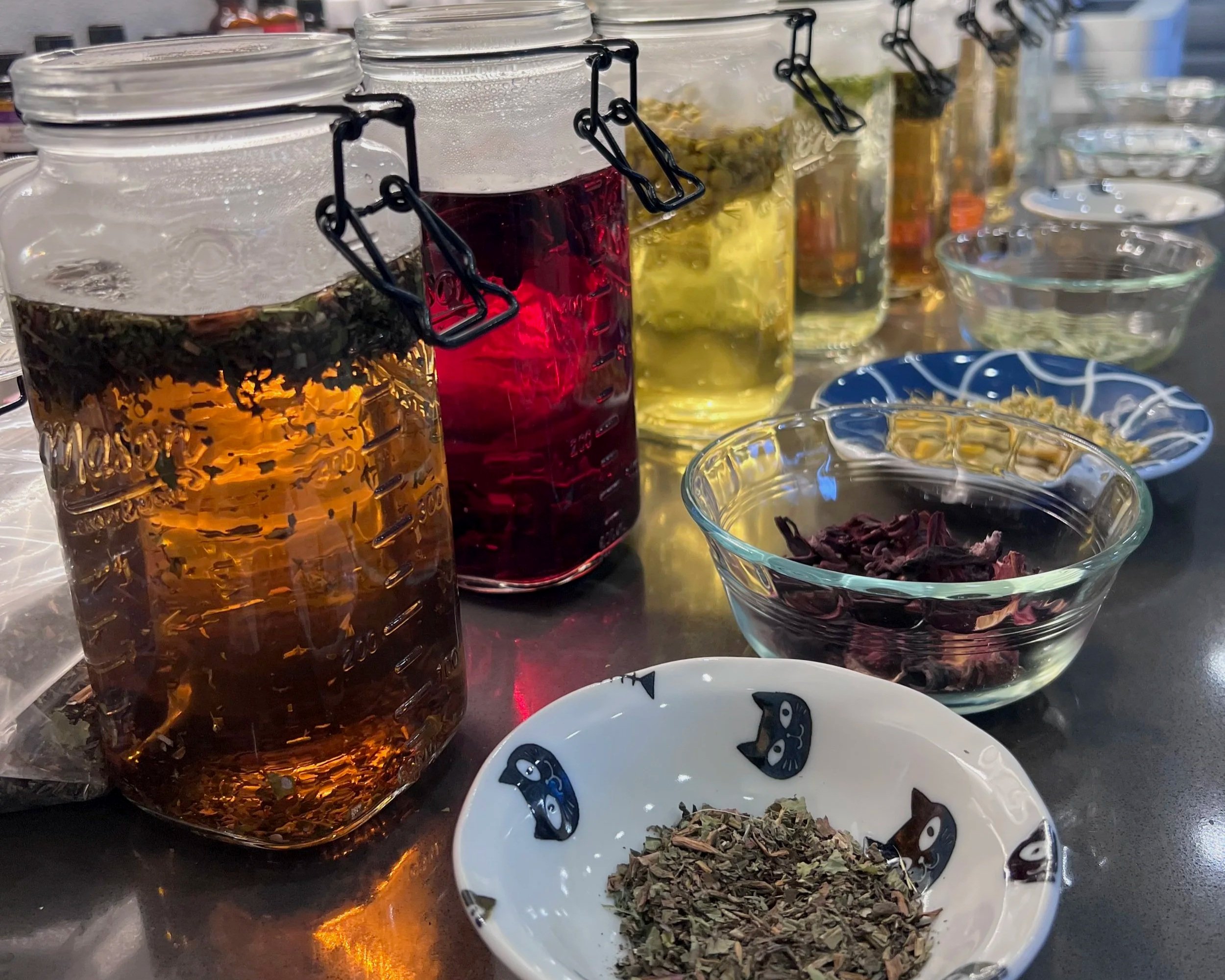A Woman’s Garden of Wellness: The Healing Herbs
The Art of Tea: Medicine, Ceremony, and Self-Care
For millennia, women have been the keepers of herbal wisdom, stewarding the knowledge of plants that heal, nourish, and restore. From the wise women of medieval Europe to the curanderas of the Americas, from Hildegard von Bingen's monastery gardens to the kitchen witches who preserved folk medicine through oral tradition, women have understood tea-making as both art and medicine. The simple act of preparing tea—measuring herbs with intention, waiting as hot water coaxes forth volatile oils and mineral salts, inhaling aromatic steam, and sitting quietly with a warm cup in hand—transforms medicine into ceremony and self-care into healing practice.
Tea offers medicine in its most gentle, absorbable form: water-soluble constituents readily crossing intestinal membranes, is warmth-promoting, boosts circulation, and enhances relaxation, the ritual itself signaling to body and mind that this moment is for restoration.
This blend of eleven herbs brings together botanical allies specifically chosen to support women through life—menstruation, pregnancy, postpartum recovery, and the transitions of perimenopause and beyond, while thriving heartily in Pacific Northwest gardens an offering their gifts through the timeless tradition of tea.
Balancing Herbal Tea for Women
Directions: To make an herbal tea infusion, steep 1-2 tablespoons of dried herbs per 8-10 ounces of boiling water for 5-15 minutes, or for a stronger cold infusion, steep overnight in the refrigerator for 6-12 hours. Cover the herbs while steeping to keep the essential oils from escaping. After steeping, strain the herbs from the liquid before serving hot or cold. Drink 1-3 cups daily.
Tea Ingredients
Use equal parts, or adjust to your preferred balance. Each of these herbs shines beautifully on its own—or combine them into custom blends to meet your body’s changing needs through the seasons: peppermint, raspberry leaf, nettle leaf, ginger root, dandelion leaf, oatstraw, horsetail, chamomile flowers, rose petals and rose hips, and hibiscus.
Peppermint Leaf (Mentha × piperita)
Peppermint thrives in Pacific Northwest gardens and offers smooth muscle relaxation that eases menstrual cramps and digestive upset. It’s a cooling, aromatic herb that supports liver health, clears the sinuses, and sharpens focus—refreshing in both hot and iced teas.
Raspberry Leaf (Rubus idaeus)
Rich in minerals like iron, calcium, and magnesium, raspberry leaf tones the uterine muscles and supports menstrual regularity and pregnancy wellness. Its mild, astringent flavor blends easily into daily teas for nourishment throughout the reproductive years.
Nettle Leaf (Urtica dioica)
One of the most nourishing herbs, nettle is packed with iron, calcium, and chlorophyll—ideal for fatigue, anemia, or post-pregnancy recovery. It supports kidney and hormone health, relieves PMS bloating, and builds strength through mineral-rich infusions.
Ginger Root (Zingiber officinale)
Warming and anti-inflammatory, ginger aids digestion, circulation, and menstrual comfort. It’s excellent for nausea, cold hands and feet, and dry winter days. Fresh or dried, it adds bright, spicy warmth to any blend.
Dandelion Leaf (Taraxacum officinale)
Dandelion supports liver detoxification and hormonal balance, helping metabolize excess estrogen. Its gentle diuretic action eases water retention, while its mild bitterness stimulates digestion and complements richer herbs.
Oatstraw (Avena sativa)
A deeply restorative tonic rich in calcium, magnesium, and B vitamins, oatstraw nourishes the nervous system—especially during stress, postpartum recovery, or menopause. Long infusions extract its minerals for a soothing, slightly sweet tea.
Horsetail (Equisetum arvense)
High in silica, horsetail strengthens hair, skin, nails, and connective tissue. Use sparingly—its mineral-rich decoction adds depth and grounding to women’s wellness blends.
Chamomile (Matricaria chamomilla)
A classic “mother herb,” chamomile calms anxiety, soothes cramps, and supports digestion. Its apple-scented tea comforts the body and mind, especially during hormonal transitions or sleepless nights.
Rose Petals & Hips (Rosa spp.)
Cooling and heart-opening, roses offer vitamin C–rich nourishment and gentle mood support. Petals soothe inflammation and ease PMS, while rosehips add tart, fruity depth and immune benefits.
Hibiscus (Hibiscus sabdariffa)
Vibrant and tangy, hibiscus cools the body, supports healthy blood pressure, and replenishes vitamin C. Beautiful hot or cold, it balances sweet and mineral-rich herbs for a ruby-red, revitalizing tea.
Whether enjoyed alone or in a custom blend, these herbs invite you to slow down, connect with your body, and honor the rhythms of your life. Each cup is a small act of self-care, a moment of ceremony, and a gentle way to nourish your body, mind, and spirit. Sip mindfully, seasonally, and with intention—allowing the natural wisdom of plants to support your wellness every day.

